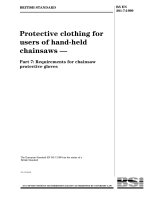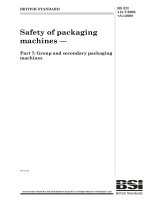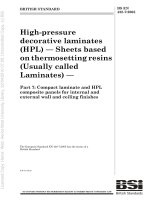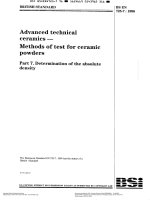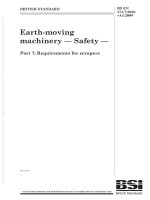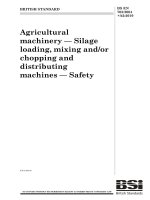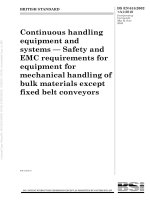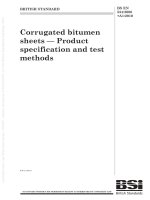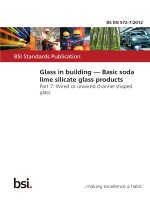Bsi bs en 61850 7 4 2010
Bạn đang xem bản rút gọn của tài liệu. Xem và tải ngay bản đầy đủ của tài liệu tại đây (2.22 MB, 186 trang )
BS EN 61850-7-4:2010
BSI Standards Publication
Communication networks
and systems for power
utility automation
Part 7-4: Basic communication structure —
Compatible logical node classes and data
object classes
NO COPYING WITHOUT BSI PERMISSION EXCEPT AS PERMITTED BY COPYRIGHT LAW
raising standards worldwide™
BS EN 61850-7-4:2010 BRITISH STANDARD
National foreword
This British Standard is the UK implementation of EN 61850-7-4:2010. It is
identical to IEC 61850-7-4:2010. It supersedes BS EN 61850-7-4:2003, which
is withdrawn.
The UK participation in its preparation was entrusted to Technical Committee
PEL/57, Power systems management and associated information exchange.
A list of organizations represented on this committee can be obtained on
request to its secretary.
This publication does not purport to include all the necessary provisions of a
contract. Users are responsible for its correct application.
© BSI 2010
ISBN 978 0 580 52973 3
ICS 33.200
Compliance with a British Standard cannot confer immunity from
legal obligations.
This British Standard was published under the authority of the Standards
Policy and Strategy Committee on 31 July 2010.
Amendments issued since publication
Amd. No. Date Text affected
EUROPEAN STANDARD BS EN 61850-7-4:2010
NORME EUROPÉENNE
EUROPÄISCHE NORM EN 61850-7-4
ICS 33.200 June 2010 Supersedes EN 61850-7-4:2003
English version
Communication networks and systems for power utility automation -
Part 7-4: Basic communication structure -
Compatible logical node classes and data object classes
(IEC 61850-7-4:2010)
Réseaux et systèmes de communication Kommunikationsnetze und -systeme
pour l’automatisation des systèmes für die Automatisierung in der elektrischen
électriques - Energieversorgung -
Partie 7-4 : Structure de communication Teil 7-4: Grundlegende
de base - Kommunikationsstruktur -
Classes de nœud logique et classes Kompatible Logikknoten-
de donnée objet compatibles und Datenklassen
(CEI 61850-7-4:2010) (IEC 61850-7-4:2010)
This European Standard was approved by CENELEC on 2010-06-01. CENELEC members are bound to comply
with the CEN/CENELEC Internal Regulations which stipulate the conditions for giving this European Standard
the status of a national standard without any alteration.
Up-to-date lists and bibliographical references concerning such national standards may be obtained on
application to the Central Secretariat or to any CENELEC member.
This European Standard exists in three official versions (English, French, German). A version in any other
language made by translation under the responsibility of a CENELEC member into its own language and notified
to the Central Secretariat has the same status as the official versions.
CENELEC members are the national electrotechnical committees of Austria, Belgium, Bulgaria, Croatia, Cyprus,
the Czech Republic, Denmark, Estonia, Finland, France, Germany, Greece, Hungary, Iceland, Ireland, Italy,
Latvia, Lithuania, Luxembourg, Malta, the Netherlands, Norway, Poland, Portugal, Romania, Slovakia, Slovenia,
Spain, Sweden, Switzerland and the United Kingdom.
CENELEC
European Committee for Electrotechnical Standardization
Comité Européen de Normalisation Electrotechnique
Europäisches Komitee für Elektrotechnische Normung
Management Centre: Avenue Marnix 17, B - 1000 Brussels
© 2010 CENELEC - All rights of exploitation in any form and by any means reserved worldwide for CENELEC members.
Ref. No. EN 61850-7-4:2010 E
BS EN 61850-7-4:2010
EN 61850-7-4:2010 - 2 -
Foreword
The text of document 57/1045/FDIS, future edition 2 of IEC 61850-7-4, prepared by IEC TC 57, Power
systems management and associated information exchange, was submitted to the IEC-CENELEC
parallel vote and was approved by CENELEC as EN 61850-7-4 on 2010-06-01.
This European Standard supersedes EN 61850-7-4:2003.
Future standards in this series will carry the new general title as cited above. Titles of existing standards
in this series will be updated at the time of the next edition.
The major technical changes with regard to EN 61850-7-4:2003 are as follows:
− corrections and clarifications according to information letter "IEC 61850-technical issues by the
IEC TC 57” (see document 57/963/INF, 2008-07-18);
− extensions for new logical nodes for the power quality domain;
− extensions for the model for statistical and historical statistical data;
− extensions regarding IEC 61850-90-1 (substation-substation communication);
− extensions for new logical nodes for monitoring functions according to EN 62271;
− new logical nodes from EN 61850-7-410 and EN 61850-7-420 of general interest.
Attention is drawn to the possibility that some of the elements of this document may be the subject of
patent rights. CEN and CENELEC shall not be held responsible for identifying any or all such patent
rights.
The following dates were fixed:
– latest date by which the EN has to be implemented (dop) 2011-03-01
at national level by publication of an identical
national standard or by endorsement
– latest date by which the national standards conflicting (dow) 2013-06-01
with the EN have to be withdrawn
Annex ZA has been added by CENELEC.
__________
Endorsement notice
The text of the International Standard IEC 61850-7-4:2010 was approved by CENELEC as a European
Standard without any modification.
In the official version, for Bibliography, the following notes have to be added for the standards indicated:
IEC 60870-5-101 NOTE Harmonized as EN 60870-5-101.
IEC 60870-5-103 NOTE Harmonized as EN 60870-5-103.
IEC 61000-4-30 NOTE Harmonized as EN 61000-4-30.
IEC 61850-6 NOTE Harmonized as EN 61850-6.
IEC 61850-7-410:2007 NOTE Harmonized as EN 61850-7-410:2007 (not modified).
IEC 61850-7-420 NOTE Harmonized as EN 61850-7-420.
IEC 61850-8 series NOTE Harmonized in EN 61850-8 series (not modified).
BS EN 61850-7-4:2010
- 3 - EN 61850-7-4:2010
IEC 61850-9 series NOTE Harmonized in EN 61850-9 series (not modified).
IEC 61850-10 NOTE Harmonized as EN 61850-10.
__________
BS EN 61850-7-4:2010
EN 61850-7-4:2010 - 4 -
Annex ZA
(normative)
Normative references to international publications
with their corresponding European publications
The following referenced documents are indispensable for the application of this document. For dated
references, only the edition cited applies. For undated references, the latest edition of the referenced
document (including any amendments) applies.
NOTE When an international publication has been modified by common modifications, indicated by (mod), the relevant EN/HD
applies.
Publication Year Title EN/HD Year
IEC 60270 2000 2001
IEC 61000-4-7 2002 High-voltage test techniques - Partial EN 60270 2002
discharge measurements
IEC 61000-4-15 - -
IEC/TS 61850-2 - Electromagnetic compatibility (EMC) - EN 61000-4-7 -
IEC 61850-5 - -
IEC 61850-7-1 200X1) Part 4-7: Testing and measurement 200X2)
IEC 61850-7-2 200X1) 200X2)
techniques - General guide on harmonics and
IEC 61850-7-3 200X1) 200X2)
interharmonics measurements and
instrumentation, for power supply systems
and equipment connected thereto
Electromagnetic compatibility (EMC) - EN 61000-4-15
Part 4-15: Testing and measurement
techniques - Flickermeter - Functional and
design specifications
Communication networks and systems in -
substations -
Part 2: Glossary
Communication networks and systems in EN 61850-5
substations -
Part 5: Communication requirements for
functions and device models
Communication networks and systems for EN 61850-7-1
power utility automation -
Part 7-1: Basic communication structure -
Principles and models
Communication networks and systems for EN 61850-7-2
power utility automation -
Part 7-2: Basic information and
communication structure - Abstract
communication service interface (ACSI)
Communication networks and systems for EN 61850-7-3
power utility automation -
Part 7-3: Basic communication structure -
Common data classes
1) To be published.
2) At draft stage.
BS EN 61850-7-4:2010
- 5 - EN 61850-7-4:2010
Publication Year Title EN/HD Year
IEC 61850-9-2 - EN 61850-9-2 -
Communication networks and systems for
IEEE C37.111 1999 power utility automation - - -
IEEE 519 1992 Part 9-2: Specific Communication Service - -
IEEE C37.2 1996 Mapping (SCSM) - Sampled values over - -
IEEE 1459 2000 ISO/IEC 8802-3 - -
IEEE 1588 - IEEE Standard for Common Format for - -
Transient Data Exchange (COMTRADE) for
Power Systems
IEEE Recommended Practises and
Requirements for Harmonic Control in
Electrical Power Systems
Electrical Power System Device Function
Numbers and Contact Designations
IEEE Trial Use Standard Definitions for the
Measurement of Electric Power Quantities
Under Sinusoidal, Nonsinusoidal, Balanced
or Unbalanced Conditions
IEEE Standard for a Precision Clock
Synchronization Protocol for Networked
Measurement and Control Systems
– 2 – BS EN 61850-7-4:2010
61850-7-4 © IEC:2010(E)
CONTENTS
INTRODUCTION ................................................................................................................... 10
1 Scope ............................................................................................................................. 11
2 Normative references......................................................................................................12
3 Terms and definitions .....................................................................................................13
4 Abbreviated terms...........................................................................................................13
5 Logical node classes.......................................................................................................19
5.1 Logical node groups ..............................................................................................19
5.2 Interpretation of logical node tables .......................................................................20
5.3 System logical nodes LN group: L .......................................................................... 21
5.3.1 LN relationships .........................................................................................21
5.3.2 LN: Physical device information Name: LPHD........................................... 22
5.3.3 LN: common logical node Name: Common LN..........................................22
5.3.4 LN: Logical node zero Name: LLN0 .......................................................... 24
5.3.5 LN: Physical communication channel supervision Name: LCCH ................ 24
5.3.6 LN: GOOSE subscription Name: LGOS ...................................................25
5.3.7 LN: Sampled value subscription Name: LSVS..........................................25
5.3.8 LN: Time management Name: LTIM .........................................................26
5.3.9 LN: Time master supervision Name: LTMS...............................................26
5.3.10 LN: Service tracking Name: LTRK ............................................................27
5.4 Logical nodes for automatic control LN Group: A..................................................27
5.4.1 Modelling remarks .....................................................................................27
5.4.2 LN: Neutral current regulator Name: ANCR ..............................................27
5.4.3 LN: Reactive power control Name: ARCO................................................. 29
5.4.4 LN: Resistor control Name: ARIS .............................................................29
5.4.5 LN: Automatic tap changer controller Name: ATCC ..................................30
5.4.6 LN: Voltage control Name: AVCO.............................................................31
5.5 Logical nodes for control LN Group: C .................................................................32
5.5.1 Modelling remarks .....................................................................................32
5.5.2 LN: Alarm handling Name: CALH .............................................................32
5.5.3 LN: Cooling group control Name: CCGR...................................................32
5.5.4 LN: Interlocking Name: CILO....................................................................33
5.5.5 LN: Point-on-wave switching Name: CPOW .............................................. 33
5.5.6 LN: Switch controller Name: CSWI ........................................................... 34
5.5.7 LN: Synchronizer controller Name: CSYN ................................................. 35
5.6 Logical nodes for functional blocks LN group F ....................................................36
5.6.1 Modelling remarks .....................................................................................36
5.6.2 LN: Counter Name: FCNT ........................................................................36
5.6.3 LN: Curve shape description Name: FCSD ............................................... 37
5.6.4 LN: Generic filter Name: FFIL ..................................................................37
5.6.5 LN: Control function output limitation Name: FLIM ....................................38
5.6.6 LN: PID regulator Name: FPID .................................................................38
5.6.7 LN: Ramp function Name: FRMP..............................................................39
5.6.8 LN: Set-point control function Name: FSPT ..............................................39
5.6.9 LN: Action at over threshold Name: FXOT ................................................40
5.6.10 LN: Action at under threshold Name: FXUT ..............................................40
BS EN 61850-7-4:2010 – 3 –
61850-7-4 © IEC:2010(E)
5.7 Logical nodes for generic references LN Group: G ...............................................41
5.8 5.7.1 Modelling remarks .....................................................................................41
5.9 5.7.2 LN: Generic automatic process control Name: GAPC ............................... 41
5.10 5.7.3 LN: Generic process I/O Name: GGIO......................................................42
5.7.4 LN: Generic log Name: GLOG ..................................................................42
5.11 5.7.5 LN: Generic security application Name: GSAL ..........................................43
Logical nodes for interfacing and archiving LN Group: I ........................................43
5.8.1 Modelling remarks .....................................................................................43
5.8.2 LN: Archiving Name: IARC .......................................................................43
5.8.3 LN: Human machine interface Name: IHMI...............................................44
5.8.4 LN: Safety alarm function Name: ISAF .....................................................44
5.8.5 LN: Telecontrol interface Name: ITCI .......................................................45
5.8.6 LN: Telemonitoring interface Name: ITMI .................................................45
5.8.7 LN: Teleprotection communication interfaces Name: ITPC .......................45
Logical nodes for mechanical and non-electric primary equipment LN group
K ...........................................................................................................................46
5.9.1 Modelling remarks .....................................................................................46
5.9.2 LN: Fan Name: KFAN ..............................................................................47
5.9.3 LN: Filter Name: KFIL ..............................................................................47
5.9.4 LN: Pump Name: KPMP ...........................................................................48
5.9.5 LN: Tank Name: KTNK.............................................................................48
5.9.6 LN: Valve control Name: KVLV.................................................................49
Logical nodes for metering and measurement LN Group: M..................................50
5.10.1 Modelling remarks ...................................................................................50
5.10.2 LN: Environmental information Name: MENV .........................................50
5.10.3 LN: Flicker measurement name Name: MFLK ........................................ 51
5.10.4 LN: Harmonics or interharmonics Name: MHAI ......................................52
5.10.5 LN: Non-phase-related harmonics or interharmonics Name: MHAN ........ 53
5.10.6 LN: Hydrological information Name: MHYD ............................................ 55
5.10.7 LN: DC measurement Name: MMDC......................................................55
5.10.8 LN: Meteorological information Name: MMET.........................................55
5.10.9 LN: Metering Name: MMTN....................................................................56
5.10.10 LN: Metering Name: MMTR....................................................................57
5.10.11 LN: Non-phase-related measurement Name: MMXN ..............................57
5.10.12 LN: Measurement Name: MMXU............................................................57
5.10.13 LN: Sequence and imbalance Name: MSQI............................................59
5.10.14 LN: Metering statistics Name: MSTA......................................................60
Logical nodes for protection functions LN Group: P ..............................................60
5.11.1 Modelling remarks ...................................................................................60
5.11.2 LN: Differential Name: PDIF...................................................................61
5.11.3 LN: Direction comparison Name: PDIR ..................................................62
5.11.4 LN: Distance Name: PDIS......................................................................63
5.11.5 LN: Directional overpower Name: PDOP ................................................ 63
5.11.6 LN: Directional underpower Name: PDUP ..............................................64
5.11.7 LN: Rate of change of frequency Name: PFRC.......................................64
5.11.8 LN: Harmonic restraint Name: PHAR .....................................................65
5.11.9 LN: Ground detector Name: PHIZ ..........................................................65
5.11.10 LN: Instantaneous overcurrent Name: PIOC...........................................66
5.11.11 LN: Motor restart inhibition Name: PMRI ................................................66
5.11.12 LN: Motor starting time supervision Name: PMSS .................................. 67
– 4 – BS EN 61850-7-4:2010
61850-7-4 © IEC:2010(E)
5.12 5.11.13 LN: Over power factor Name: POPF ...................................................... 67
5.13 5.11.14 LN: Phase angle measuring Name: PPAM .............................................67
5.11.15 LN: Rotor protection Name: PRTR .........................................................68
5.14 5.11.16 LN: Protection scheme Name: PSCH .....................................................68
5.11.17 LN: Sensitive directional earthfault Name: PSDE....................................69
5.11.18 LN: Transient earth fault Name: PTEF ...................................................70
5.11.19 LN: Thyristor protection Name: PTHF .................................................... 70
5.11.20 LN: Time overcurrent Name: PTOC .......................................................70
5.11.21 LN: Overfrequency Name: PTOF ...........................................................71
5.11.22 LN: Overvoltage Name: PTOV ...............................................................72
5.11.23 LN: Protection trip conditioning Name: PTRC .........................................72
5.11.24 LN: Thermal overload Name: PTTR .......................................................73
5.11.25 LN: Undercurrent Name: PTUC..............................................................73
5.11.26 LN: Underfrequency Name: PTUF..........................................................74
5.11.27 LN: Undervoltage Name: PTUV..............................................................74
5.11.28 LN: Underpower factor Name: PUPF...................................................... 75
5.11.29 LN: Voltage controlled time overcurrent Name: PVOC ............................ 75
5.11.30 LN: Volts per Hz Name: PVPH ...............................................................76
5.11.31 LN: Zero speed or underspeed Name: PZSU..........................................77
Logical nodes for power quality events LN Group: Q ............................................77
5.12.1 Modelling remarks .....................................................................................77
5.12.2 LN: Frequency variation Name: QFVR......................................................77
5.12.3 LN: Current transient Name: QITR ...........................................................78
5.12.4 LN: Current unbalance variation Name: QIUB...........................................78
5.12.5 LN: Voltage transient Name: QVTR ..........................................................79
5.12.6 LN: Voltage unbalance variation Name: QVUB .........................................79
5.12.7 LN: Voltage variation Name: QVVR ..........................................................80
Logical nodes for protection related functions LN Group: R ..................................80
5.13.1 Modelling remarks ...................................................................................80
5.13.2 LN: Disturbance recorder channel analogue Name: RADR .....................81
5.13.3 LN: Disturbance recorder channel binary Name: RBDR ..........................81
5.13.4 LN: Breaker failure Name: RBRF ...........................................................82
5.13.5 LN: Directional element Name: RDIR .....................................................82
5.13.6 LN: Disturbance recorder function Name: RDRE ....................................83
5.13.7 LN: Disturbance record handling Name: RDRS ......................................84
5.13.8 LN: Fault locator Name: RFLO ...............................................................84
5.13.9 LN: Differential measurements Name: RMXU...........................................84
5.13.10 LN: Power swing detection/blocking Name: RPSB .................................. 85
5.13.11 LN: Autoreclosing Name: RREC.............................................................86
5.13.12 LN: Synchronism-check Name: RSYN .................................................... 86
Logical nodes for supervision and monitoring LN Group: S ...................................87
5.14.1 Modelling remarks ...................................................................................87
5.14.2 LN: Monitoring and diagnostics for arcs Name: SARC ............................88
5.14.3 LN: Circuit breaker supervision Name: SCBR.........................................88
5.14.4 LN: Insulation medium supervision (gas) Name: SIMG ...........................89
5.14.5 LN: Insulation medium supervision (liquid) Name: SIML .........................90
5.14.6 LN: Tap changer supervision Name: SLTC.............................................91
5.14.7 LN: Supervision of operating mechanism Name: SOPM ......................... 91
5.14.8 LN: Monitoring and diagnostics for partial discharges Name: SPDC........92
BS EN 61850-7-4:2010 – 5 –
61850-7-4 © IEC:2010(E)
5.15 5.14.9 LN: Power transformer supervision Name: SPTR ................................... 93
5.14.10 LN: Circuit switch supervision Name: SSWI ........................................... 93
5.16 5.14.11 LN: Temperature supervision Name: STMP............................................94
5.17 5.14.12 LN: Vibration supervision Name: SVBR ..................................................95
5.18 Logical nodes for instrument transformers and sensors LN Group: T ....................96
5.15.1 Modelling remarks ...................................................................................96
5.15.2 LN: Angle Name: TANG .........................................................................96
5.15.3 LN: Axial displacement Name: TAXD .....................................................96
5.15.4 LN: Current transformer Name: TCTR....................................................97
5.15.5 LN: Distance Name: TDST.....................................................................97
5.15.6 LN: Liquid flow Name: TFLW .................................................................98
5.15.7 LN: Frequency Name: TFRQ..................................................................98
5.15.8 LN: Generic sensor Name: TGSN ..........................................................99
5.15.9 LN: Humidity Name: THUM ....................................................................99
5.15.10 LN: Media level Name: TLVL ............................................................... 100
5.15.11 LN: Magnetic field Name: TMGF .......................................................... 100
5.15.12 LN: Movement sensor Name: TMVM .................................................... 100
5.15.13 LN: Position indicator Name: TPOS ..................................................... 101
5.15.14 LN: Pressure sensor Name: TPRS ....................................................... 101
5.15.15 LN: Rotation transmitter Name: TRTN.................................................. 102
5.15.16 LN: Sound pressure sensor Name: TSND ............................................ 102
5.15.17 LN: Temperature sensor Name: TTMP................................................. 103
5.15.18 LN: Mechanical tension / stress Name: TTNS ...................................... 103
5.15.19 LN: Vibration sensor Name: TVBR ....................................................... 104
5.15.20 LN: Voltage transformer Name: TVTR.................................................. 104
5.15.21 LN: Water acidity Name: TWPH........................................................... 105
Logical nodes for switchgear LN Group: X.......................................................... 105
5.16.1 Modelling remarks ................................................................................... 105
5.16.2 LN: Circuit breaker Name: XCBR ........................................................... 105
5.16.3 LN: Circuit switch Name: XSWI .............................................................. 106
Logical nodes for power transformers LN Group: Y ............................................ 107
5.17.1 Modelling remarks ................................................................................... 107
5.17.2 LN: Earth fault neutralizer (Petersen coil) Name: YEFN .......................... 107
5.17.3 LN: Tap changer Name: YLTC ............................................................... 107
5.17.4 LN: Power shunt Name: YPSH ............................................................... 108
5.17.5 LN: Power transformer Name: YPTR ...................................................... 108
Logical nodes for further power system equipment LN Group: Z ......................... 109
5.18.1 Modelling remarks ................................................................................. 109
5.18.2 LN: Auxiliary network Name: ZAXN ...................................................... 109
5.18.3 LN: Battery Name: ZBAT ..................................................................... 109
5.18.4 LN: Bushing Name: ZBSH.................................................................... 110
5.18.5 LN: Power cable Name: ZCAB ............................................................. 110
5.18.6 LN: Capacitor bank Name: ZCAP......................................................... 111
5.18.7 LN: Converter Name: ZCON ................................................................ 111
5.18.8 LN: Generator Name: ZGEN ................................................................ 111
5.18.9 LN: Gas insulated line Name: ZGIL ...................................................... 112
5.18.10 LN: Power overhead line Name: ZLIN .................................................. 112
5.18.11 LN: Motor Name: ZMOT....................................................................... 113
5.18.12 LN: Reactor Name: ZREA .................................................................... 113
– 6 – BS EN 61850-7-4:2010
61850-7-4 © IEC:2010(E)
5.18.13 LN: Resistor Name: ZRES ................................................................... 114
5.18.14 LN: Rotating reactive component Name: ZRRC.................................... 114
5.18.15 LN: Surge arrestor Name: ZSAR .......................................................... 115
5.18.16 LN: Semi-conductor controlled rectifier Name: ZSCR ........................... 115
5.18.17 LN: Synchronous machine Name: ZSMC.............................................. 115
5.18.18 LN: Thyristor controlled frequency converter Name: ZTCF ................... 117
5.18.19 LN: Thyristor controlled reactive component Name: ZTCR.................... 117
6 Data object name semantics ......................................................................................... 117
Annex A (normative) Interpretation of mode and behaviour ................................................. 156
Annex B (normative) Local / Remote concept ..................................................................... 158
Annex C (informative) Deprecated logical node classes ...................................................... 160
Annex D (informative) Relationship between this standard and IEC 61850-5 ....................... 161
Annex E (informative) Algorithms used in logical nodes for automatic control...................... 162
Annex F (normative) Statistical calculation ......................................................................... 167
Annex G (normative) Functional relationship of data objects of autorecloser RREC............. 172
Annex H (normative) SCL enumerations ............................................................................. 173
Bibliography ........................................................................................................................ 179
Figure 1 – Overview of this standard .....................................................................................12
Figure 2 – LOGICAL NODE relationships...............................................................................21
Figure E.1 – Example of curve based on an indexed gate position providing water flow........ 162
Figure E.2 – Example of curve based on an indexed guide vane position (x axis) vs. net
head (y axis) giving an interpolated runner blade position (Z axis)........................................ 163
Figure E.3 – Example of a proportional-integral-derivate controller....................................... 164
Figure E.4 – Example of a power stabilisation system .......................................................... 165
Figure E.5 – Example of a ramp generator .......................................................................... 165
Figure E.6 – Example of an interface with a set-point algorithm ........................................... 166
Figure F.1 – Statistical calculation of a vector ...................................................................... 168
Figure F.2 – Examples of statistical calculations .................................................................. 170
Figure G.1 – Diagram of autorecloser function..................................................................... 172
Table 1 – List of logical node groups.......................................................................................... 19
Table 2 – Interpretation of logical node tables............................................................................ 20
Table 3 – Relation between IEC 61850-5 and IEC 61850-7-4 for automatic control LNs............. 27
Table 4 – Relation between IEC 61850-5 and IEC 61850-7-4 for control LNs ............................. 32
Table 5 – Conditional attributes in FPID ..................................................................................... 39
Table 6 – Relation between IEC 61850-5 and IEC 61850-7-4 for metering and
measurement LNs ..................................................................................................................... 50
Table 7 – Relation between IEC 61850-5 and IEC 61850-7-4 (this standard) for protection LNs 60
Table 8 – Relation between IEC 61850-5 and IEC 61850-7-4 for protection related LN ............. 80
Table 9 – Relation between IEC 61850-5 and IEC 61850-7-4 for supervision and
monitoring LNs...................................................................................................................... 87
Table 10 – Description of data objects................................................................................. 117
Table A.1 – Values of mode and behaviour.......................................................................... 156
Table A.2 – Definition of mode and behaviour...................................................................... 157
BS EN 61850-7-4:2010 – 7 –
61850-7-4 © IEC:2010(E)
Table B.1 – Relationship between Loc/Rem data objects and control authority ..................... 159
Table D.1 – Relationship between IEC 61850-5 and this standard for some
miscellaneous LNs .............................................................................................................. 161
– 10 – BS EN 61850-7-4:2010
61850-7-4 © IEC:2010(E)
INTRODUCTION
This part of IEC 61850 is part of a set of standards, the IEC 61850 series. IEC 61850 defines
communication networks and systems for power utility automation, and more specially the
communication architecture for subsystems such as substation automation systems. The sum
of all subsystems may result also in the description of the communication architecture for the
overall power system management. The defined architecture provided in specific parts of
IEC 61850-7-x gives both a power utility specific data model and a substation domain specific
data model with abstract definitions of data objects classes and services independently from
the specific protocol stacks, implementations, and operating systems. The mapping of these
abstract classes and services to communication stacks is outside the scope of IEC 61850-7-x
and may be found in IEC 61850-8-x and in IEC 61850-9-x.
IEC 61850-7-1 gives an overview of the basic communication architecture to be used for all
applications in the power system domain. IEC 61850-7-3 defines common attribute types and
common data classes related to all applications in the power system domain. The attributes of
the common data classes may be accessed using services defined in IEC 61850-7-2. These
common data classes are used in this part to define the compatible data object classes.
To reach interoperability, all data objects in the data model need a strong definition with regard
to syntax and semantics. The semantics of the data objects is mainly provided by names
assigned to common logical nodes defined in this part and the data objects they contain, as
defined in this basic part, and dedicated logical nodes defined in domain specific parts such as
for hydro power control systems. Interoperability is easiest if as much as possible of the data
objects are defined as mandatory. Because of different approaches and technical features,
some data objects, especially settings, were declared as optional in this edition of the standard.
There are also data objects which were declared as conditional, i.e. they will become
mandatory under some well-defined conditions. After some experience has been gained with
this standard, this decision may be reviewed in the next edition of this part.
It should be noted that data objects with full semantics are only one of the elements required to
achieve interoperability. The standardized access to the data objects is defined in compatible,
power utility and domain specific services (see IEC 61850-7-2). Since data objects and
services are hosted by devices (IED), a proper device model is also needed. To describe both
the device capabilities and the interaction of the devices in the related system, a configuration
language is also needed, as defined in IEC 61850-6 by the substation configuration description
language (SCL).
The compatible logical node name and data object name definitions found in this part and the
associated semantics are fixed. The syntax of the type definitions of all data objects classes is
governed by abstract definitions provided in IEC 61850-7-2 and IEC 61850-7-3. Not all features
of logical nodes are listed in this part; for example, data sets and logs are covered in
IEC 61850-7-2.
BS EN 61850-7-4:2010 – 11 –
61850-7-4 © IEC:2010(E)
COMMUNICATION NETWORKS AND
SYSTEMS FOR POWER UTILITY AUTOMATION –
Part 7-4: Basic communication structure –
Compatible logical node classes and data object classes
1 Scope
This part of IEC 61850 specifies the information model of devices and functions generally
related to common use regarding applications in systems for power utility automation. It also
contains the information model of devices and function-related applications in substations. In
particular, it specifies the compatible logical node names and data object names for
communication between intelligent electronic devices (IED). This includes the relationship
between logical nodes and data objects.
The logical node names and data object names defined in this document are part of the class
model introduced in IEC 61850-7-1 and defined in IEC 61850-7-2. The names defined in this
document are used to build the hierarchical object references applied for communicating with
IEDs in systems for power utility automation and, especially, with IEDs in substations and on
distribution feeders. The naming conventions of IEC 61850-7-2 are applied in this part.
To avoid private, incompatible extensions, this part specifies normative naming rules for
multiple instances and private, compatible extensions of logical node (LN) classes and data
object names. Any definition is based on IEC 61850 or on referenced well identified public
documents.
This part does not provide tutorial material. It is recommended to read parts IEC 61850-5
and IEC 61850-7-1 first, in conjunction with IEC 61850-7-3, and IEC 61850-7-2.
This standard is applicable to describe device models and functions of substation and feeder
equipment. The concepts defined in this standard are also applied to describe device models
and functions for:
• substation-to-substation information exchange,
• substation-to-control centre information exchange,
• power plant-to-control centre information exchange,
• information exchange for distributed generation,
• information exchange for distributed automation, or
• information exchange for metering.
Figure 1 provides a general overview of this standard. The groups of logical nodes defined in
this standard are shown in Figure 1, ordered according to some semantic meaning, for
instance different control levels such as plant level, unit level, etc. For convenience, the logical
nodes are defined below in alphabetical order.
– 12 – BS EN 61850-7-4:2010
61850-7-4 © IEC:2010(E)
General LN information
System LNs . . . L
Interface LNs . . . I
Unit/Bay level . . . C, P, R,…
Process/Equipment level . K, S, X, T, Y, Z
General use . . . G, F
Data semantics
Annex
Figure 1 – Overview of this standard IEC 1102/03
2 Normative references
The following referenced documents are indispensable for the application of this document. For
dated references, only the edition cited applies. For undated references, the latest edition of
the referenced document (including any amendments) applies.
IEC 60270:2000, High-voltage test techniques – Partial discharge measurements
IEC 61000-4-7:2002, Electromagnetic compatibility (EMC) – Part 4-7: Testing and
measurement techniques – General guide on harmonics and interharmonics measurements
and instrumentation, for power supply systems and equipment connected thereto
IEC 61000-4-15, Electromagnetic compatibility (EMC) – Part 4-15: Testing and measurement
techniques – Flickermeter – Functional and design specifications
IEC 61850-2, Communication networks and systems in substations – Part 2: Glossary
IEC 61850-5, Communication networks and systems in substations – Part 5: Communication
requirements for functions and device models
IEC 61850-7-1:___ 1, Communication networks and systems for power utility automation – Part
7-1: Basic communication structure – Principles and models
___________
1 To be published.
BS EN 61850-7-4:2010 – 13 –
61850-7-4 © IEC:2010(E)
IEC 61850-7-2:___ 2, Communication networks and systems for power utility automation – Part
7-2: Basic information and communication structure – Abstract communication service interface
(ACSI)
IEC 61850-7-3:___ 3, Communication networks and systems for power utility automation – Part
7-3: Basic communication structure – Common data classes
IEC 61850-9-2, Communication networks and systems for power utility automation – Part 9-2:
Specific Communication Service Mapping (SCSM) – Sampled values over ISO/IEC 8802-3
IEEE C37.111:1999, IEEE Standard Common Format for Transient Data Exchange
(COMTRADE) for Power Systems
IEEE 519:1992, IEEE Recommended Practises and Requirements for Harmonic Control in
Electrical Power Systems
IEEE C37.2:1996, Electrical Power System Device Function Numbers and Contact Designation
IEEE 1459:2000, IEEE Trial-Use Standard Definitions for the Measurement of Electric Power
Quantities Under Sinusoidal, Nonsinusoidal, Balanced, or Unbalanced Conditions
IEEE 1588, Precision clock synchronization protocol for networked measurement and control
systems
3 Terms and definitions
For the purposes of this document, the terms and definitions given in IEC 61850-2 and
IEC 61850-7-2 apply.
4 Abbreviated terms
The following terms are used to build concatenated data object names. For example, ChNum is
constructed by using two terms "Ch" which stands for "Channel" and "Num" which stands for
"Number". Thus the concatenated name represents a "channel number".
Term Description Term Description
Alm Alarm
A Current Amp Current non-phase-related
An Analogue
Acs Access Ang Angle
Ap Access point
Abr Abrasion App Apparent
Arc Arc
Abs Absolute Area Area
Auth Authorisation
AC AC, alternating current Auto Automatic
Aux Auxiliary
Acc Accuracy Av Average
AWatt Wattmetric component of current
Act Action, activity
Acu Acoustic
Adj Adjustment
Adp Adapter, adaptation
Age Ageing
Air Air
Alg Algorithm
___________
2 To be published.
3 To be published.
– 14 – BS EN 61850-7-4:2010
61850-7-4 © IEC:2010(E)
Term Description Term Description
Ax Axial CO Carbon monoxide
B Bushing CO2 Carbon dioxide
Base Base Col Coil
Bat Battery Conf Configuration
Beh Behaviour Cons Constant
Ber Bit error rate Con Contact
Bias Bias Cor Correction
Bin Binary Core Core
Blb Bulb Crd Coordination
Blk Block, blocked Crit Critical
Bnd Band Crv Curve
Bo Bottom CT Current transducer
Bst Boost Ctl Control
Bus Bus Ctr Center
C Carbon Cur Current
C2H2 Acetylene Cvr Cover, cover level
C2H4 Ethylene Cyc Cycle
C2H6 Ethane D Derivate
Cap Capability Day Day
Capac Capacitance dB Decibel
Car Carrier Dct Direct
CB Circuit breaker Dea Dead
Cdt Credit Den Density
CE Cooling equipment Det Detected
Cel Cell Detun Detuning
Cf Crest factor DExt De-excitation
Cff Coefficient Dew Dew
Cfg Configuration Dff Diffuse
CG Core ground Dgr Degree
Ch Channel Diag Diagnostics
CH4 Methane Dif Differential, difference
Cha Charger Dip Dip
Chg Change Dir Direction
Chk Check Dis Distance
Chr Characteristic Dsp Displacement
Circ Circulating, circuit Dl Delay
Clc Calculate, calculated Dlt Delete
Clk Clock, clockwise Dmd Demand
Cloud Cloud Dn Down
Clr Clear DPCSO Double point controllable status output
Cls Close Direct, quadrature, and zero axis
Cndct Conductivity DQ0 quantities
Cnt Counter Drag hand
Cmbu Combustible, combustion Drag Day
Cmd Command Day Drive
Drv Device state
DS
BS EN 61850-7-4:2010 – 15 –
61850-7-4 © IEC:2010(E)
Term
Term Description Gn Description
Dsc Discrepancy Gnd Generator
Dsch Discharge Gr Ground
Dur Duration Grd Group
Dv Deviation Grn Guard
EC Earth Coil Gri Green
Echo Echo Gust Grid
EE External equipment H Gust
EF Earth fault H2 Harmonics (phase-related)
Emg Emergency H2O Hydrogen
Ems Emissions Ha Water
En Energy Health Harmonics (non-phase-related)
Ena Enabled Heat Health
End End Hi Heater, heating
Env Environment Hor High, highest
Eq Equalization, equal HP Horizontal
Err Error Hum Hot point
Ev Evaluation Hy Humidity
Evt Event Hyd Hydraulics, hydraulic system
Ex External Hz Hydrological, hydro, water
Exc Exceeded I Frequency
Excl Exclusion Imb Integral
Exp Expired Imp Imbalance
Ext Excitation In Impedance non-phase-related
F Float Ina Input
FA Fault arc Iner Inactivity
Fact Factor Incr Inertia
Fail Failure Ind Increment
Fan Fan Inh Indication
Fer Frame error rate Ins Inhibit
Fil Filter, filtration Insol Insulation
Fish Fish Int Insolation
Fld Field Intr Integer
Fll Fall Intv Interrupt, interruption
Flood Flood ISCSO Interval
Flt Fault K Integer status controllable status output
Flush Flush Kck Constant
Flw Flow Key Kicker
FPF Forward power flow km Key
Fu Fuse L Kilometre
Full Full Last Lower
Fwd Forward Ld Last
Gas Gas LD Lead
Gen General LDC Logical device
Go Goose LDCR Line drop compensation
Goose control block reference (see Line drop compensation resistance
GoCBRef IEC 61850-7-2)
– 16 – BS EN 61850-7-4:2010
61850-7-4 © IEC:2010(E)
Term Description Term
LDCX Line drop compensation reactance Nit Description
LDCZ Line drop compensation impedance Ng Nitrogen
Leak Leakage Nom Negative
LED Light-emitting diode Num Nominal, normalising
Len Length NSQ Number
Lev Level O2 Average partial discharge current
Lg Lag O3 Oxygen
Lim Limit Ofs Ozon, trioxygen
Lin Line Oil Offset
Liv Live Oo Oil
LN Logical node Op Out of
Lo Low Opn Operate, operating
LO Lockout Out Open
Loc Local Ov Output
Lod Load, loading Ovl Over, override, overflow
Lok Locked P Overload
Loop Loop Pa Proportional
Los Loss Pap Partial
Lst List Par Paper
LTC Load tap changer Pct Parallel
M Minutes Per Percent, percentage
Data object is mandatory or optional or PF Periodic, period
M/O/C conditional Ph Power factor
Made PH Phase
Made Magnetic, magnitude PhsA Acidity, value of pH
Mag Maximum PhsB Phase L1
Max Membrane PhsC Phase L2
Mbr Memory PNV Phase L3
Mem Minimum Phy Phase-to-neutral voltage
Min Mirror Pi Physical
Mir Multiplier, multiple Pls Instantaneous P
Mlt Mode Plt Pulse
Mod Month Pmp Plate, long-term flicker severity
Month Motor Po Pump
Mot Milliseconds Pol Polar
Ms Moisture Pos Polarizing
Mst Main tank PosA Position
MT Method PosB Position phase L1
Mth Movement, moving PosC Position phase L2
Mvm Nitrogen dioxide Pot Position phase L3
N2 Name POW Potentiometer
Nam Name (see Note) PP Point on wave switching
Name Needs commissioning ppm Phase to phase
(see IEC 61850-7-2) PPV Parts per million
NdsCom Net sum Pre Phase to phase voltage
Neutral Pre-
Net
Neut
